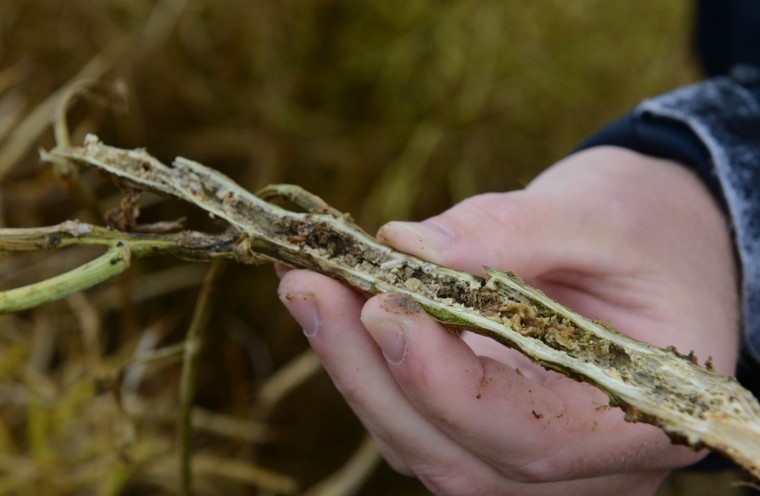The effect seen now is stunted plants with thin main stems and far fewer branches and that have died off early – so has all the implications for a reduced yield, warns Syngenta Technical Field Trialist, Quentin Ham.
Look closer, and there is ample evidence of cankers developed on the stem base of crops, he says, with a key characteristic of the black speckled dots around the canker. Breaking open the stem will reveal a decaying mush, which can be easily differentiated from Sclerotinia if there are no black sclerotia evident within the stem.
“Last season’s infection will inevitably have an impact on yield this harvest. But it also poses a serious risk for the new crop this autumn,” warns Quentin. “Old crop cankers, mixed in with the stubble trash, will be the source of infective spores. Every Rain events over the autumn trigger a continuous further spore release and infection events.”
He advocates growers should assess the risk to new crops, based on the susceptibility of varieties sown; drilling date; seedling size; weather conditions and the appearance of Phoma spots on the leaf.
“Warmer conditions at the time of infection will lead to quicker movement of infection down the leaf petiole and into the stem; the smaller the leaf at the time of initial spotting, the greater the risk of spread. Growers should be monitoring crops and treating with Plover as soon as the Phoma leaf spot threshold is reached,” he advises.
“Early infection in the autumn typically leads to bigger and more damaging stem cankers in the spring, with greater yield losses,” he points out.
“Phoma should always be the primary concern for initial autumn fungicide treatment. This year’s trials have shown that using Plover early in the autumn programme can achieve good levels of leaf spotting control and limit the yield sapping effects of stem cankers, as well as reducing the potential infection source for the new following OSR crop.”
Recommendations for Phoma treatment this autumn is to treat with Plover at 0.25 l/ha when 10% of plants show signs of initial leaf spots from September to November, typically repeated four to six weeks later with an additional 0.25 l/ha treatment if reinfection occurs. With the later application – or a single Plover application at 0.35 l/ha if initial Phoma infection does not appear until after November – growers could consider adding tebuconazole as a tank mix to further bolster Light Leaf Spot control.




